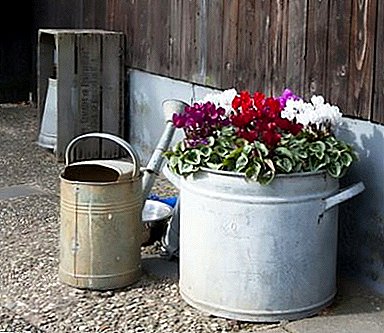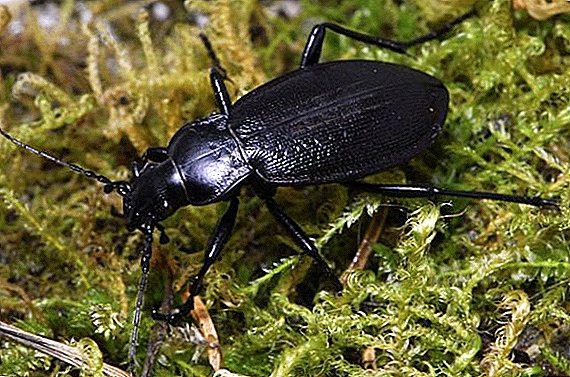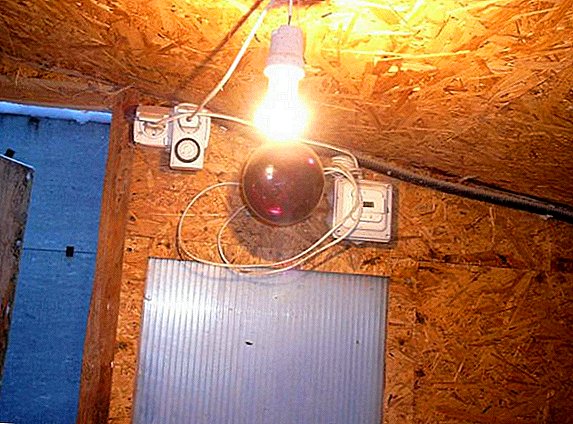 The period of puberty, egg production, as well as the quality of meat and egg products depend on the length of daylight in chickens. With low activity, poultry loses productivity and becomes vulnerable to various diseases. Therefore, veterinarians advise throughout the year to keep animals in the conditions of daily 14-hour coverage. How to properly equip the lamp in the chicken coop, which prefer, where to install them and when to include - we will tell about this later in the article.
The period of puberty, egg production, as well as the quality of meat and egg products depend on the length of daylight in chickens. With low activity, poultry loses productivity and becomes vulnerable to various diseases. Therefore, veterinarians advise throughout the year to keep animals in the conditions of daily 14-hour coverage. How to properly equip the lamp in the chicken coop, which prefer, where to install them and when to include - we will tell about this later in the article.
Winter lighting
With the arrival of spring, the length of daylight hours in accordance with the recommendations of veterinarians increases to 14 hours. This is a very beneficial effect on the livelihoods of the inhabitants of the house. At 5 am, they awaken along with the sunrise, and in the evening they return to their roost only when it starts to get dark. Such conditions are natural for poultry: it develops well, grows rapidly and is carried. 
Did you know? Chickens never rush in the dark. Even when it is time to lay an egg, the bird will still wait for the dawn or the inclusion of light.In October, when the days are much shorter, activity decreases in the hens. By the winter period, they completely stop egg-laying. In addition, the uncomfortable situation in the hen house is very favorable for the disease environment. Therefore, many owners resort to artificial lighting of livestock in the cold season.
Learn how to properly make lighting for a country house.
With the right intensity and brightness of the light, it is possible to maintain a high egg production rate, as well as the former qualities of carcasses. But even the slightest mistakes in equipment can do more harm than good. Weigh all the positive and negative sides.
pros
Artificial lighting in the house in winter is justified by the fact that:
- chickens continue to trot continuously;
- due to the deceived biorhythms, the young growth is better developed;
- livestock has excellent physical health and rarely gets sick;
- in the light, feeding processes go faster and with better quality, swallowed food is better absorbed;
- the sizes and quality indicators of meat, and also eggs improve;
- minimizes the percentage of injuries among coop residents;
- increased chick survival.

Did you know? The most expensive breed of chickens today are rare representatives of the Indonesian breed. "Ayam Chemani"which has long been considered extinct. The exotic nature of this unique bird is in its beautiful black color, which is characteristic not only of plumage, but also of the skin, eyes, beak and even the internal organs of birds. It is characteristic that the color remains even after heat treatment of the carcass. Many tourists believe that such a rooster will bring everlasting happiness to the family. Therefore, the price for a couple of domesticated birds starts from 5 thousand US dollars.
Minuses
Not all experts see a positive in the artificial lighting of the house:
- the chicken body due to the constant egg-laying does not have time to replenish the reserves of calcium, as well as to fully update the plumage.
- there is a high risk of fire, because the lamps operate uncontrollably at night;
- taking into account the cost of electricity in the winter period, the cost of maintaining the house increases significantly.

Did you know? In the ranking of the rarest chicken breeds, the Vietnamese fight heavyweights took the lead - "Ga Dong Tao". In the world there are only about 300 individuals of this breed, which are distinguished by a hypertrophied nut-like crest, a heavy constitution and very thick scaly paws. Characteristically, the girth of an adult rooster's leg corresponds to the girth of a child's hand.
Types of lamps
A modern range of illuminations suitable for the chicken coop allows you to make a choice on any request. You can dwell on ordinary incandescent bulbs or experiment with LED, fluorescent, energy-saving variations. What is the difference between them, what are the disadvantages and main advantages - let's understand together.
Read also about how to make a feed cutter for chickens, build and equip a chicken coop, as well as make a roost, a cage and a nest.
Incandescent lamps
This option, many owners are beginning to like more on the shelf counters, because it is the cheapest. Its ecological component is also attractive. But in the process of operation, the initial low cost does not justify itself at all. 
Advantages:
- ease of use;
- easy replacement;
- good illumination;
- possibility of use in harsh climatic conditions;
- suitability for heating chick boxes;
- parallel poultry house disinfection and minor additional heating.
Disadvantages:
- fragility;
- high power consumption.
Important! Periodic darkness is important for all birds, without exception. At this time, bone tissue is formed, calcium metabolism changes (which is important for the durability of the shell), important factors of immunity are produced.
Fluorescent lamps
They are well proven in everyday life. Their distinctive feature is even white light. Convenient for mounting in horizontal and vertical position. 
Advantages:
- reliability;
- continuous operation;
- satisfactory efficiency in power consumption;
- affordable price.
Disadvantages:
- the need for special disposal;
- environmental hazards.
Energy-saving lamps
This option bribes insignificant costs of electricity consumption, which affects the total cost of maintaining the house. 
Advantages:
- the ability to adjust the desired spectrum of light;
- low cost.
Disadvantages:
- high cost;
- the presence of mercury inside the lamp, which adversely affects the environment;
- fragility (imbalance of price and quality).
LED bulbs
This option is favorably distinguished by the duration of its work. In the assortment you can find special models designed for lighting poultry farms. Usually they are placed on the ceiling. 
Advantages:
- continuous operation over 50 thousand hours;
- ease of use;
- unpretentiousness to the conditions and independence from external temperatures;
- resistance to dampness;
- protection from dust and sedimentation of solid particles that may be in the hen house;
- the ability to adjust the intensity of the flow of light;
- efficiency in power consumption.
Important! The color of the lamp affects poultry differently. When choosing lighting, keep in mind that blue color of chickens calms, orange - stimulates the work of their reproductive function, green - promotes growth, and muffled red prevents the hens from pulling eggs.
The brightness of the light in the hen house
Poultry does not like very bright light. Therefore, it is wrong to think that a large number of light fixtures will benefit animals. In order not to overdo the lighting, experts advise to proceed from the power of the selected lamps and the area of the chicken coop. For every square meter of space, 1 watt is enough. For example, if you have a house on 10 squares, you can restrict one lamp to 60 watts. In the case of large structures, it will be necessary to take into account specific areas that must necessarily remain shaded.  It is desirable to give light at the end of autumn, when birds complete the natural process of molting. In winter, when the birds spend all their time indoors, each dawn should begin with the turning on of the lamp, and the sunset should be followed by turning it off. To facilitate the maintenance of the chicken coop, many owners set automatic timers that allow you to adjust not only the duration of the lamps, but also the intensity and brightness of the light flux.
It is desirable to give light at the end of autumn, when birds complete the natural process of molting. In winter, when the birds spend all their time indoors, each dawn should begin with the turning on of the lamp, and the sunset should be followed by turning it off. To facilitate the maintenance of the chicken coop, many owners set automatic timers that allow you to adjust not only the duration of the lamps, but also the intensity and brightness of the light flux.
Important! If the lamp is covered with a protective glass canopy, its service life will double.
Where to install the lamp
Some novice poultry farmers are convinced that the lighting in the hen house is appropriate over the nests, and try to illuminate these places as best as possible. But experts are categorically opposed to such an initiative, considering that the brightest light should be above the feeders and drinkers. In this case, the lamp must be fixed in the traditional way to the ceiling. In this position, they contribute to the good absorption of food and the proper development of internal bioprocesses. When nests and perches are shaded, chickens have no cause for concern.
Learn how to do your own drinkers and feeders for chickens.
When to turn on the light
If you decided that in the winter throughout the day the light would be on in the hen house, you were deeply mistaken. According to experts, it is necessary to include it only in the morning and in the evening. Usually start at six in the morning. And when it becomes bright outside, the lights are turned off before dusk. Closer to 16:00 again include. It is desirable that the lamp worked at least until eight o'clock in the evening. Do not overload the birds too long daylight hours. After all, such conditions will only exhaust them.  That's all the secrets that help poultry farmers to extend the egg production of their wards and to achieve high productivity from them. In order to equip a room, it is enough of the knowledge and skills that each owner possesses. And if you try, then with the help of purchased relays you can save yourself from early ups and manual regulation of the lamp operation period.
That's all the secrets that help poultry farmers to extend the egg production of their wards and to achieve high productivity from them. In order to equip a room, it is enough of the knowledge and skills that each owner possesses. And if you try, then with the help of purchased relays you can save yourself from early ups and manual regulation of the lamp operation period.












